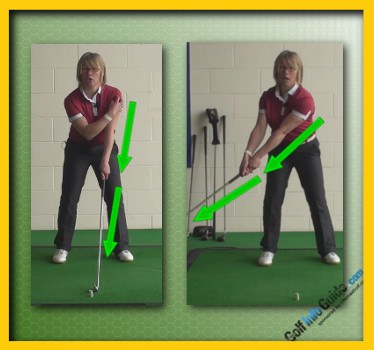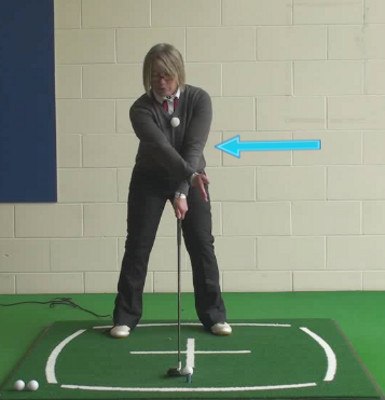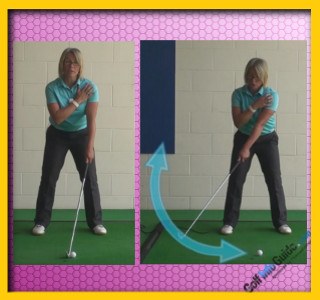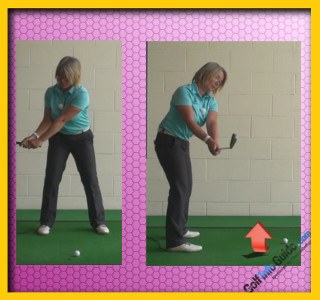
Once you've have obtained a good, solid setup position, the start of the golf swing is a key movement to set the right trend and tone for the rest of your golf swing.
It is ideal to make a one piece takeaway movement for the first three or four feet of the backswing or until the club reaches hip height. A good feeling to get the club back in a one piece movement is to focus solely on turning the left shoulder under the chin to initiate the backswing. If the hands and the arms can be passive during the first three or four feet, a wider one piece backswing will be attained.
Excessive use of the hands, wrists or forearms during the start of the swing can take the club on the wrong line. It can be too inconsistent, and can cause the club to move back to quickly. A connected one piece backswing should result in a low and slow, wide, arcing backswing.
To check you are maintaining the right back swing position, setup face on into a mirror and focus on how you only try to move your left shoulder under the chin, which causes the club to move back away from the golf ball. Repeat this process until it feels solid and natural before completing your backswing.

How to Start Swing with Proper Coordination Between Left Arm and Shoulder
Coordination in the golf swing is critical. Having a variety of sound fundamentals in your swing is going to lead to a good result if you are able to coordinate those moves properly. There isn't much of a challenge to be found in the task of learning the right movements – the challenge is in bringing those movements together into a cohesive unit. Many golfers are never quite able to put the 'whole package' together, so if you can do so, you will find yourself comfortably ahead of the competition.
Having good coordination in your swing starts from the very moment that you begin to take the club back away from the ball. Plenty of golfers go wrong right from the start, with faulty mechanics that make it nearly impossible to get back on track by the time impact is reached at the bottom of the swing. Even the seemingly small details in your swing are incredibly important, and the takeaway falls into that category. It is easy to overlook the importance of the takeaway, but a good player will understand just how crucial it is to the swing as a whole.
For a right handed golfer, the connection between the left arm and left shoulder are particularly important (for a left handed golfer, it would be the right shoulder and right arm). The two are connected anatomically, obviously, as your shoulder ties your arm in to the rest of your body. More than that, however, they need to be connected in the way they move during the early moments of the swing. A big part of the power that you are able to make in your swing will be determined by the quality of the takeaway, and specifically how well you are able to stay connected. You will often hear professional golfers speaking of trying to 'stay connected', which is something that is always near the top of their priority list. When a pro golfer does a good job of keeping everything connected early in the swing, the result is usually a powerful, reliable motion.
If you are serious about taking your golf game to a new level, you need to be willing to focus on the small details that can make you a quality player. It will always be the small details that determine your success or failure on the course, yet many golfers are unwilling to put in the time and effort necessary to refine their skills. You don't have to be able to practice seven days a week in order to make progress in your game, but you do need find your way to the range on a semi-regular basis if you are going to tighten up things like your takeaway.
All of the content below is based on a right handed golfer. If you happen to play left handed, please be sure to reverse the directions as necessary.

The Goal
So what is it that you are looking for from your takeaway? Ultimately, it is a unified takeaway that needs to get your swing started. That means that rather than having various parts of your body doing different things and moving in different directions, you should have everything going the same way (or staying still). As you would guess from the title of this article, two of the key ingredients in your takeaway are going to be the left shoulder and left arm. These are the parts of the body that will be responsible for getting the club started. If you have previously found yourself standing over the ball while unsure of what part of your body should start the swing, you will have to wonder no more – use your left arm and left shoulder and you will be on track for a great swing.
A good takeaway motion looks incredibly simple, as there are hardly any moving parts at all. You sweep the club away using a rotation of your left shoulder and arm, while your hands remain quiet. To many golfers, this kind of a takeaway feels awkward at first because they are used to using their hands more actively. Using the hands in the takeaway feels like a powerful way to get the swing started because the club head will be moving quickly – but it can actually lead to a number of problems. A 'handsy' takeaway can put the club off plane right from the start, and it can also cause issues with your tempo. If you are currently a player who loves to use hands during the takeaway, your game will benefit in the long run if you can work to break yourself of this habit.
When you watch golf on TV, have you ever noticed how smooth and effortless the pros are able to make the golf swing look? That is due in large part to the one-piece takeaway that they use. Since you don't actually hit the ball until the club comes back down to impact, you have plenty of time to build up speed in your swing. You don't need to swing quickly during the takeaway – you only need to swing fast when you are contacting the ball. With that in mind, you should be able to convince yourself that it is okay to use a slow and easy takeaway to get your swing started. You have plenty of time to generate speed throughout the rest of your backswing and downswing, so relax early on and allow the club to get off to a good start.
The great thing about learning how to use this kind of takeaway is that it will apply across the board to all of the different shots you hit during a round of golf. No matter what shot you are hitting – from a long drive to a short putt – you will be using this same takeaway to get started. Knowing exactly how you are going to start the club in motion will give you peace of mind and will help you focus on the task at hand before every shot. Plenty of golfers have had trouble over the years with freezing up over the ball while trying to decide how they should get started. You won't have that problem. Knowing exactly how your swing is going to start, you will be able to take your stance with confidence each time.
One of the worst things you can do in the golf swing is get off to a bad start. Since the swing happens so quickly, there really isn't time to recover from a poor start to your motion. If you make a few mistakes early in the swing – such as during the takeaway – the chances are that you will never recover. Instead, the shot you eventually hit will not live up to its potential because you got yourself off track right from the first move you made. Take the time and effort to work your way into a quality takeaway to start your swing and the game will get much easier as a result.

It's All About Address
If you would like to build a great takeaway that you can use for all of your shots, you actually need to look back even farther into your technique to deal with your address position. That's right – before the club even starts moving, you already need to be concerned with how you are positioning your body. It isn't good enough to just stand up next to the ball and fire away. By thinking carefully about how you position your body at address, you will stand a much better chance of making a nice takeaway and a successful golf swing.
Following is a list of points which can all be found in a solid address position –
- Flexed knees. What do your knees have to do with the movements of your left shoulder and arm? Quite a bit, actually. When you flex your knees at address, you will be providing yourself with a solid foundation on which to build a swing. Without that foundation, you won't be able to hold your body still while turning your shoulder and arm away from the target. This is one of the basic fundamentals of the game that is frequently overlooked, especially by those who are just getting started. Anytime you stand over the ball to hit a shot, remember to flex your knees slightly to create a platform for your swing.
- Chin up. This is a point that is particularly important when it comes to how your left shoulder moves away from the target. If you tuck your chin down into your chest at address – which is what many golfers do, thinking they need to 'keep their head down' – you will actually be blocking the path that your shoulder needs to use in the backswing. Instead, keep your chin up while making sure your eyes remain down on the ball. Having your chin up will clear the way for your shoulder to turn away from the target, and you should be able to maintain better posture throughout the swing as well.
- Relaxed grip. If the goal is to avoid excessive hand movement during the takeaway, one of the best things you can do is maintain a light grip on the club. When you squeeze the club too tightly at address, your hands will be more likely to get involved in the action. By keeping your fingers relaxed around the grip, you should be able to move the club back with your shoulder and arm without any interference from either hand. This is another one of those points that may take some time to adjust to, so practice a light grip on some short shots before moving up to full swings.
- Square shoulders. The last point on our list has to do with getting your shoulders squared up to the target line. That means that your shoulders should form a line which is parallel to the line that you have picked out for the target of your swing. Note – that does not mean that your shoulders have to be parallel with a line going to the hole. The hole may or may not be your actual target depending on the design of the hole. For instance, if you are playing a hole which is guarded by water on the right, you may choose to aim left for safety. Get your shoulders into a position which is parallel to your selected target line and you should be able to swing the club back on a great plane time after time.
It there is anything in golf that is less exciting than working on your takeaway, it is probably working on your address position. While nobody is promising that all of your practice sessions will be thrilling, they will be beneficial to the quality of your swing. Those who are willing to invest in the details – such as the takeaway and the stance – are the ones who are going to rise to the top of the pile. Natural talent is no match for excellent preparation and proper fundamentals, so put the points above into your stance and look forward to improved results.

One Handed Lessons
To learn how to feel the proper takeaway in your golf swing, one of the best things you can do is to practice the start of your swing with just the left hand on the club. By dropping the right hand off of the grip and putting it in your pocket or behind your back, you will almost be forced to complete the takeaway properly. Since you no longer have the strength of the right hand to help your left, you probably won't be able to get your hands (or hand, in this case) involved too early. Therefore, your only option will be to sweep the club back with your left shoulder and arm.
Since you aren't going to hit any balls while doing this quick drill, you can even practice it at home when you have a few minutes free. Take any club from your back and just go back and forth from address to a foot or so into your backswing. Even without making a single full swing, you can dramatically improve your game by learning what a proper takeaway feels like. Feel free to repeat this drill as many times as you would like, whether at home or at the driving range (or even on the course before hitting a shot).
If you would like to enhance this drill to have it include your right hand and a full swing, follow the steps below to do so.
- Find a spot where you can practice making full swings safely. You aren't going to be hitting the golf ball with these swings, so you still don't have to be at the course or range. However, you will be swinging all the way back and through, so make sure you are in a place where you can do so without hitting anything (or anyone).
- To start, complete the drill as it was highlighted above. Take your stance with just your left hand on the club, and use your left shoulder and arm to start the swing. Make sure your left hand isn't manipulating the club – keep your left side connected and turn your shoulder under your chin and away from the target nicely.
- Once you have moved the club head back about a foot from address (no need to be exact with that measurement), add your right hand to the grip and continue on to the rest of the swing. At first, you will likely need to stop the takeaway, add your hand, and then continue. However, with practice, you should be able to do this all in one motion. Essentially, you are trying to complete the takeaway with your left hand only prior to adding your right hand for the rest of the journey.
- When done correctly, this drill will give you the best of both worlds – it will allow you to feel the proper takeaway without your right hand interfering, but it will then let you make the rest of your swing. Repeat this drill as often as you would like, and even consider using it out on the course from time to time as a practice swing mechanism.
Hopefully, this combination drill will help you to see how you can make a powerful swing without using your hands in the takeaway. Once your right hand is added back onto the grip, you will feel that you have all of your power available and you will be able to make a dynamic move through the rest of the shot. That first foot of the swing is only important in that it gets the club started on the right plane, so don't allow your right hand to mess things up. Use this drill to fully understand the control that your left side should have over the club at the start of the swing and you will be on track toward better ball striking.

Stay With It On the Course
As you already know, the walk from the driving range to the first tee is the longest one in golf. Not literally, of course, but figuratively. Every golfer knows just how hard it is to carry all of the good fundamentals and feelings that have been developed on the range over to that first tee shot. It is as if you become a different person from the range to the first tee, and everything you 'figured out' on the range quickly goes out the window. It is no overstatement to say that the biggest challenge you face as a golfer is figuring out how to perform on the course as you do on the range.
One of the best ways to translate your performance is to focus on executing your takeaway correctly. The problem that golfers run into on the course is all mental – there is nothing that has changed with your physically from the range to the course. What has changed is the way you are thinking, so you need to find a way to get your mind back into the same place that it was in while you were practicing. To focus your mind in on the task at hand, make your takeaway a top priority. Since the takeaway is something so simple and specific, it has the ability to help your mind relax and work toward a goal. Tell yourself that the only thing you have to do is make a great takeaway – the rest of the swing will take care of itself from there.
During your practice sessions, you have already learned how to swing the club. Even if you don't love the status of your full swing at the moment, you are going to have to make due with it for the round you are playing. There will be time to tinker with your swing later, but for now, you have to make the best of what you have. That means getting 'out of your own way' mentally while allowing your body to do what it has learned on the range. As long as you get off to a good start, your natural ability should take over and your body will swing through to the finish. Give yourself that good start through a coordinated takeaway with your left shoulder and arm, and you suddenly will be able to hit the ball on the course nearly as well as you do on the range.
The takeaway is incredibly important, yet often overlooked. There is no doubt that there are other parts of the swing you can work on which will be more exciting, but few will be as helpful to your game as a quality takeaway. Keep the connection strong between your left shoulder and your left arm as the club swings back and better ball striking will be around the corner.






